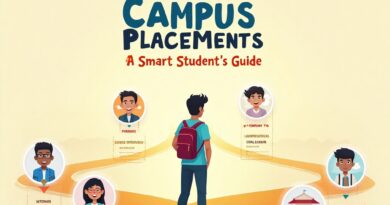Roadmap to Become a Software Developer in 2025
🖥️ Roadmap to Become a Software Developer in 2025 – Step-by-Step Guide for Students and Beginners
💡 Introduction
Software development continues to be one of the most in-demand and rewarding careers in 2025. Whether you are a student, a career switcher, or a tech enthusiast, this comprehensive roadmap will guide you from the basics of programming to becoming a professional software developer ready for the modern job market.
Let’s decode the Roadmap to Become a Software Developer in 2025 — in a way that’s practical, realistic, and beginner-friendly 🚀.

🔧 Understand What a Software Developer Really Does
A software developer is someone who builds applications, websites, and systems that solve problems or serve users. They write code, test it, fix bugs, collaborate with teams, and continuously learn new technologies.
💡 Real-time example: Think about apps like Instagram, Swiggy, or Zomato. Behind each app is a team of developers who designed how it works, coded it, and kept improving it.
📘 Step 1 – Start with the Basics of Programming
The first step is to learn how to code. Choose a beginner-friendly language like:
-
Python (best for beginners, AI, web development)
-
JavaScript (great for web development)
-
Java (used in enterprise apps and Android)
🧠 Tips:
-
Use free platforms like W3Schools, GeeksforGeeks, and Codecademy.
-
Try writing small programs daily (like a calculator or a to-do app).
💡 Real-time example: Many freshers who start with Python often build small games like “Guess the Number” in their first month of learning.
Also Read,
| Internships: The Ultimate Guide to Landing Your Dream Job |
🧠 Step 2 – Understand Computer Science Fundamentals
Programming alone isn’t enough. Understanding CS fundamentals will help you write better, faster, and more efficient code.
Key topics:
-
Data Structures and Algorithms (DSA)
-
Object-Oriented Programming (OOP)
-
Operating Systems
-
Computer Networks
-
Databases (SQL, NoSQL)
📚 Resources: Harvard’s CS50 on YouTube, or the NPTEL courses available for free.
🌍 Step 3 – Choose a Development Path
Depending on your interest, you can choose different paths:
-
Frontend Development – HTML, CSS, JavaScript, React
-
Backend Development – Node.js, Django, Express.js, Ruby on Rails
-
Full-Stack Development – Both frontend + backend
-
Mobile App Development – Flutter, React Native, Kotlin
-
DevOps & Cloud Engineering – AWS, Docker, Kubernetes
-
Game Development – Unity, Unreal Engine
💡 Example: If you love designing interfaces, go for frontend. If you enjoy solving problems on the backend, explore Node.js or Python Django.
🛠️ Step 4 – Learn Version Control (Git & GitHub)
Git is a tool to track your code changes. GitHub is a platform to store and share your code with others.
Why it’s essential:
-
Companies look for GitHub profiles
-
Collaboration becomes easy
-
Shows your growth and projects
📌 Tip: Try contributing to open-source projects on GitHub.
🧑💻 Step 5 – Build Real Projects
Start applying what you’ve learned by building real-world projects. They will boost your confidence and strengthen your portfolio.
📁 Project ideas:
-
Personal portfolio website
-
Weather app using APIs
-
To-do list app
-
Chat application
-
Blogging platform
💡 Real-time example: A student who built a personal expense tracker using React and Firebase landed an internship within 3 months.
📄 Step 6 – Create a Developer Portfolio
A portfolio is your digital resume. It should include:
-
About Me
-
Skills & Tech Stack
-
Projects with GitHub links
-
Resume download
-
Contact information
🛠️ Tools: Use GitHub Pages, Netlify, or Vercel to host your portfolio for free.
📚 Step 7 – Learn Problem Solving & Practice DSA
Problem-solving is a critical skill for cracking interviews. Practice on platforms like:
🔁 Make it a habit to solve 1–2 problems daily.
💡 Tip: Focus on concepts like Arrays, Strings, Trees, Recursion, Dynamic Programming.
🎓 Step 8 – Get Internships & Practical Experience
Internships offer:
-
Real-world experience
-
Team collaboration
-
Exposure to tech stacks used in companies
💼 Platforms to apply:
💡 Real-time example: A college student with 2 internships on their resume has 3x more chances of landing a job after graduation.
🔎 Step 9 – Prepare for Technical Interviews
Most interviews include:
-
DSA problems
-
System design (for experienced roles)
-
Projects discussion
-
HR questions
🎤 Mock Interviews & Resources:
-
Pramp (free mock interviews)
-
InterviewBit (interview prep)
-
Cracking the Coding Interview (book)
💡 Tip: Practice speaking about your projects clearly—it shows confidence and understanding.
🌐 Step 10 – Stay Updated & Join Developer Communities
Technology evolves constantly. Stay relevant by:
-
Following tech blogs (like Hashnode, Medium)
-
Watching YouTube channels (TechWithTim, CodeWithHarry)
-
Joining communities on Discord, Reddit, and LinkedIn
🏆 Popular Developer Events:
-
Hackathons (Smart India Hackathon, Devpost)
-
Google Developer Groups (GDG)
-
GitHub Universe
💼 Optional – Go for Certifications (If Needed)
While not always necessary, certifications can boost your resume.
Popular Certifications:
-
AWS Certified Developer
-
Google Associate Android Developer
-
Meta Front-End Developer (Coursera)
-
Microsoft Azure Fundamentals
📜 Tip: Only take certifications if they add value to your profile.
💥Bonus – Freelancing & Personal Branding
Once you have a few skills, you can also earn by freelancing.
🌍 Freelancing Platforms:
-
Fiverr
-
Upwork
-
Toptal
📢 Start a tech blog, post regularly on LinkedIn, or create coding videos. Personal branding makes you stand out!
🏁 Conclusion
Becoming a software developer in 2025 is not about having a CS degree. It’s about consistency, practical skills, and real-world experience.
👉 Follow this roadmap, build meaningful projects, connect with the community, and stay curious. You’re not just learning to code — you’re learning to build the future.
✅ Summary Checklist
| Step | Task |
|---|---|
| 1 | Learn Basic Programming (Python/JavaScript) |
| 2 | Understand CS Fundamentals |
| 3 | Choose a Specialization |
| 4 | Master Git & GitHub |
| 5 | Build Projects |
| 6 | Create a Portfolio |
| 7 | Practice DSA Daily |
| 8 | Get Internships |
| 9 | Prepare for Interviews |
| 10 | Join Communities |
| 11 | Bonus: Freelancing & Personal Branding |
📤 Stay Updated with NextGen Careers Hub
📱 Follow us on Instagram
📺 Subscribe to us on YouTube
Please share our website with others: NextGenCareersHub.in





